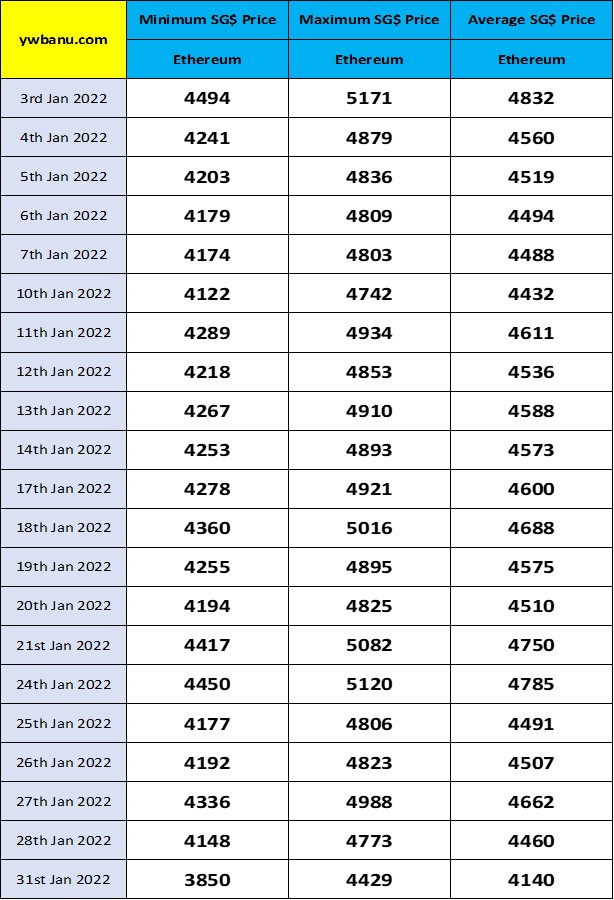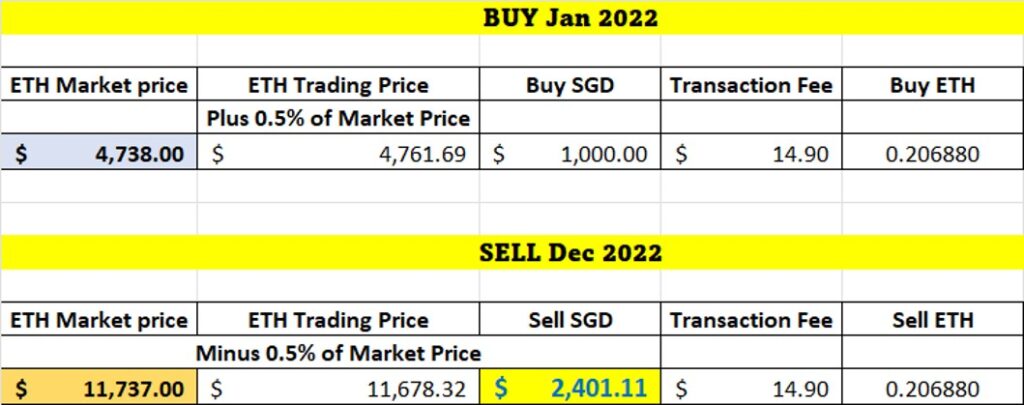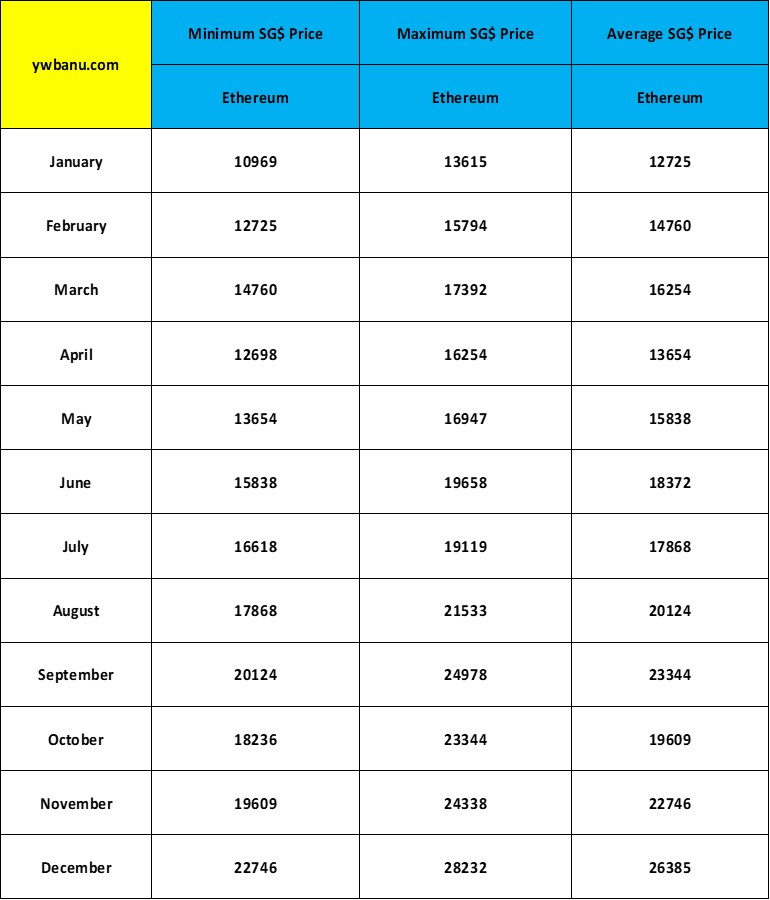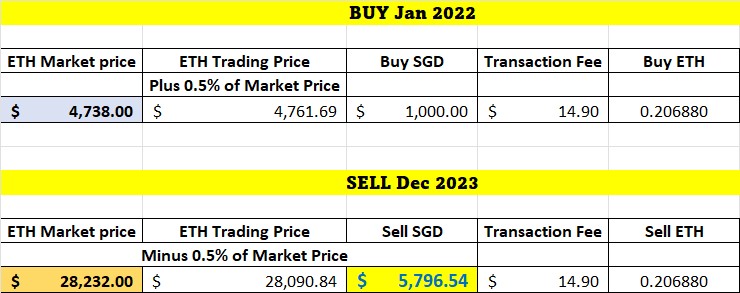Table of Contents
Ethereum price prediction for January 2022, Ethereum Price Prediction for 2022 and Ethereum Price Prediction for 2023 in Singapore. Bitcoin and Ethereum are considered to be the bluechip currencies, which influence the sentiments of the entire market. Let’s do a thorough prediction so that you can make the most profit from the fluctuating prices.
Ether (ETH) in 2021
In 2021, the race for Ether (ETH) was consolidated, capable of reaching half the capitalization of Bitcoin. ETH execution began at the beginning of the year, growing from around SG$ 810 to over SG$ 5400. The highest market price ever reached for ETH is SG$ 6609, and it will be interesting to see how this cryptocurrency will perform in 2022. The value of Bitcoin and Ethereum considered the bluechip in cryptocurrencies, has increased by 35 to 40% in the year 2021.
The Ethereum ecosystem is attracting significant investor attention, mainly thanks to the proposed change to the Proof-of-Stake (POS) protocol. Switching from a proof-of-work (POW) system to a POS system makes the entire network use less energy and is more environmentally friendly.
Ethereum technology is increasingly at the centre of the spread of cryptocurrencies and blockchain solutions. Many new cryptocurrencies use Ethereum’s ERC-20 system, and many decentralized applications are born on this blockchain.
The transition from a POW to a POS system is part of the great ETH 2.0 project. The initiative was announced in 2020, but it is unclear when the ecosystem update will be rolled out.
The market expects to see news about this area in Ethereum Price Prediction for 2022, making ETH one of the most exciting cryptocurrencies for next year.
Ethereum Price Prediction for January 2022

From the above, we can see that Ethereum is set to go lowest at SG$4494 and reach a Maximum of SG$5171 on Jan 3rd 2022. I am using a Crypto exchange website called Gemini.com. Gemini.com is the right cryptocurrency exchange for beginners as their fees are pretty straightforward. Gemini.com platform is easy to understand and very safe.
If I buy Ethereum for $1000 at the lowest price of SG$4494.00, based on the calculation below, I receive 0.218113 eth.
This means in net price 0.218113 = SG$1000.

On the same day, when I sell my 0.218113 eth when the price is at the highest of $5171.00, I will receive $1107.32.
This means in net price I sold 0.218113 = $1107.32.

My Profit for the day is $107.32.
Within a day you gain $100 plus in crypto exchange if you know how to play it right.
Ethereum Price Prediction for 2022
Let’s look at Ethereum Price Prediction for 2022 and see how much profit you can make if you hold your Eth and sell at the end of the year 2022.

Source : Gemini.com
When you buy ETH in Jan 2022 at SG$4738 and sell at the end of the year at SG$11737. You gain a Profit of SG$1401.11.

Ethereum Price Prediction for 2023
What will it be beyond Ethereum Price Prediction for 2022? According to the latest long-term forecast, Ethereum price will hit SG$19658 by the end of 2023. This means you can make a Profit of SG$4796.54 if you have been holding the Eth which you bought in Jan 2022 and sell it in December 2023. You can take a look at the calculation given below.

Source : Gemini.com

Source : Gemini.com
Ethereum backgroud
In August 2014, Ethereum launched its native token, ether, through an initial coin offering (ICO). Some 50 million ETHs were sold at a price of US$0.31 per coin, raising over $16 million for the project.
Unlike many other cryptocurrencies, Ethereum’s cryptocurrency has an unbounded supply, meaning there is no limit to how many ethers can enter circulation.
How Ethereum works
Like Bitcoin, Ethereum has its own blockchain where a global network of more than 2.4 million computers known as “nodes” maintains a record of transactions. Anyone can run an Ethereum node and participate in validating the network provided they have the right hardware, knowledge and time to commit to it.
There are three main types of nodes that operate on the Ethereum network.
• Full nodes: These copy and verify all transactions on the Ethereum blockchain, as well as execute smart contract instructions known as opcodes. Full nodes shouldn’t be confused with miners (see example below).
• Light nodes: These maintain only a partial record of the blockchain and request the rest of the data from full nodes. As the name suggests, these nodes can run on lighter devices such as mobile phones and don’t need to operate 24/7.
• Full archive nodes: These stores the entire history of the Ethereum blockchain, including previous “states” – or the information on the blockchain – and are used for tools like block explorers.
An easy way to understand the difference between miners and full nodes is to think of miners as archaeologists out in the field uncovering historical artefacts and full nodes as administrators at a national museum who maintain a record of all the archaeologists’ findings.
The main difference between a full node and a full archive node is that a full archive node does everything a full node does but also compiles an archive of all previous states.
The Ethereum blockchain relies on miners to discover new blocks. These are like digital boxes that store transaction information and other data. Miners compete using specialized computing equipment to win the chance to be the next person to add a block to the chain and get rewarded with transaction fees (from the transactions they add to the block) and “block rewards.”
Block rewards are new ether coins that are created when each new block is discovered and are given to the successful miner for their efforts. Once a block is added, the rest of the mining network verifies it to make sure the balances are correct and the transaction isn’t a “double-spend,” i.e., someone isn’t trying to spend money they don’t have. Full nodes then make a record of the final data.
However, unlike Bitcoin, Ethereum full nodes also need to keep track of the state (the current information) of all of these applications, including each user’s balance, all the smart contract code, where it’s all stored and any changes that are made. This means running an Ethereum node requires significantly more storage and is expensive to run compared with a bitcoin node.
Here’s a summary of what’s stored in each node:
• Accounts: This shows how much ether the user has.
• Smart contract code: Ethereum stores smart contracts, which describe the rules that need to be met for money to be unlocked and transferred.
• Smart contract state: The state of the smart contracts.
Ether and gas
Ether (ETH) is the main token of the Ethereum blockchain and acts as the primary “fuel” that powers all activity on it. “Gas” refers to an amount of ether that’s needed to perform a certain function on the network, such as:
• Sending transactions (swapping, trading or moving Ethereum-based tokens around)
• Interacting with decentralized applications
• Creating smart contracts
• Minting non-fungible tokens, or NFTs
How much gas you pay for each action on the Ethereum blockchain is calculated based on two things:
• Gas cost: The computational energy an operation on Ethereum requires to be processed and executed on the network. This is denominated in units of gas.
• Gas price: The rate set by the user for converting gas into units of ether. These units are usually denominated in “gwei,” which is a unit of Ethereum equivalent to 0.000000001 ether.
Cost of an operation on Ethereum = gas cost x gas price
Source : Gemini.com

2 thoughts on “Most Precise Ethereum Price Prediction for 2022 – Maximum Profit for Singaporean”